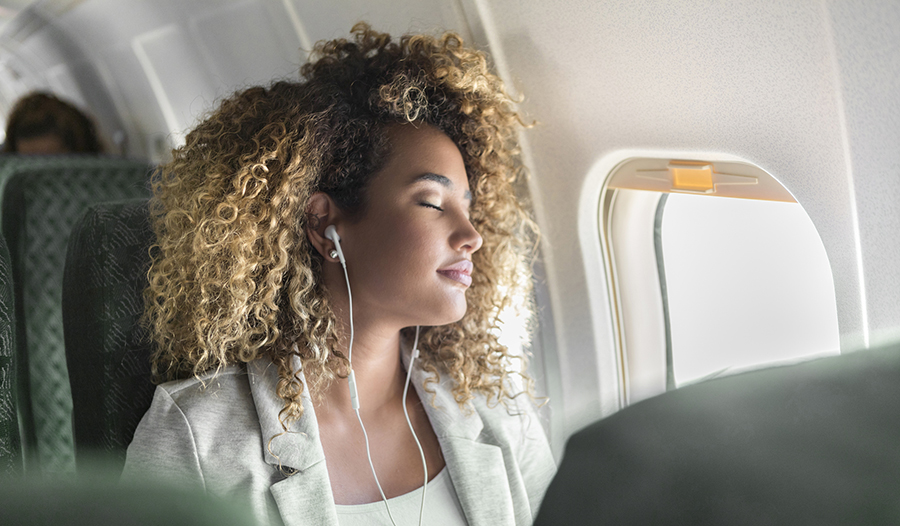10 Tips on How to Stay Healthy While Flying

Whether you are traveling for business or pleasure, it’s no fun to fall ill once you arrive at your destination. Here are 10 essentials tips to keep in mind if you want to avoid getting sick the next time you board a plane.
1. Keep Your Hands Clean
Bring sanitizing gel or wipes on board with you. The Centers for Disease Control and Prevention recommends using a sanitizer containing at least 60% alcohol. Natural products without harmful chemicals are also available. A hand sanitizer should be applied after touching any unsanitized surface on the airplane before you eat or drink, and before your hands touch your eyes, nose, or mouth.
Use the sanitizer to wipe down your seat, seatbelt, armrests, tray table, and touchscreen entertainment center. Bacteria can survive several days after being left on surfaces inside a plane. One study showed that E. coli lasted for up to 4 days, while MRSA lingered for at least a week.
Avoid touching the seat pocket in front of you. Sanitizers are not very effective on the seat pocket fabric and people tend to use these pockets as trash cans placing almost anything in them. Discarded items range from used tissues to dirty diapers.
It’s also a good idea to apply sanitizer to your hands even after washing in the plane’s lavatory sink. Onboard tap water does not have a good track record. Back in 2004, the Environmental Protection Agency (EPA) determined that all aircraft public water systems were not complaint with the National Primary Drinking Water Regulations. High levels of fecal bacteria were found in the drinking water of 15 of the 327 planes that the EPA tested.
In 2009, the agency created new regulations for aircraft water systems. However, the 2019 Airline Water Study showed that the quality of drinking water was variable among airlines, and several of them may have provided unhealthy water to their passengers.
2. Drink Plenty of Clean Water
Given the possibility of water contamination, it is wise not to drink any water provided on board unless it comes from a sealed can or bottle. Avoid tea or coffee made on the plane as well. You might consider bringing your own empty reusable water bottle, and after passing through airport security screening, fill it up at a drinking fountain before boarding.
Drink plenty of water starting two days prior to travel and regularly throughout your flight, as it can be very dry on an airplane - the humidity level is often below 20%. Aim to take in about eight ounces of water for every hour on board. When you become dehydrated, your mucus membranes dry out which leaves you more vulnerable to viral and bacterial infection.
Dehydration can also cause annoying symptoms like headache, sore throat, and dry eyes and skin. Such symptoms can persist for quite a while after you reach your destination.
Limit beverages that contain caffeine or alcohol. Because of the diuretic effect, such beverages can be very dehydrating. Furthermore, since oxygen levels are reduced at cruising altitude, less oxygen is getting to your brain and this increases the effects of any alcohol you consume.
3. Use the Air Vent
Modern aircraft are equipped with high-tech air filters which clear away 99.9995% of dust and microbes from the air, according to the International Air Transport Association. Moreover, the air only circulates in part of the cabin because the ventilation is compartmentalized.
Unfortunately, if someone sitting next you sneezes due to flu or cold, a pathogen may find its way into your airways before it gets to the air filter. To combat this, utilize the air vent to essentially blow away microbes from your personal space. Adjust the air to a medium setting and position the overhead vent so that the air current runs directly in front of your head. If you place your hands in your lap, you should feel the current there, not on your face.
4. Choose Your Seat Wisely
Opt for a window seat whenever possible. The airflow on a plane is designed to come down from the top of the cabin and out the vents on the floor next to the window. Because of this direction of airflow, passengers in window seats tend to be exposed to fewer airborne microbes than those in aisle seats.
Should you find yourself sitting near someone who is ill, know that studies have found that the risk of infection drops outside a zone of three rows. But you would need to be within 1-2 rows of a sick person who is actively coughing and not acting to suppress it to be at risk for respiratory transmission of a virus.
Also consider selecting a seat that is not close to the lavatory, as it tends to have people gathering around it or passing by frequently. It’s not unreasonable to suspect that those spending the most time in the bathroom might be the ones on the plane who are already sick.
5. Eat Healthy and Lightly During the Flight
Stay away from processed airline meals and snacks. Look for salads and fresh fruit or vegetables. Avoid any foods that may cause gas or bloating – corn, beans, onions, or cruciferous vegetables like cabbage, broccoli, and cauliflower. Limit spicy foods that may induce acid reflux. When in flight, gases in your body expand by one-third and digestion slows down.
6. Stay Calm
Stress can wreak havoc on your body. Plan to have ample time to get to the airport. Use the early check-in option on your mobile device the day before travel. Wear comfortable clothing that won’t be troublesome to manage to go through the security line. For example, opt for a zippered outer layer instead of a pullover or button-up jacket.
7. Get Enough Rest
You are more susceptible to illness when you lack adequate sleep because your immune system is weakened. Get at least 7-8 hours of sleep the night before your flight. You may find that a drop of lavender oil on your temple or pillow at bedtime may help you relax and get a good sleep.
Before you travel, change your sleep schedule to match that of your destination. If you’re traveling from west to east, then you’ll need to go to bed earlier. Try shifting bedtime earlier by 30 minutes each night for several nights before you leave.
If you’re having trouble getting to sleep earlier, a small dose of melatonin (0.5 mg) taken 90 minutes prior to the bedtime of your destination may be helpful. However, do not use melatonin long-term. Possible side effects include nightmares, daytime grogginess, and increased blood sugar. Medications for seizures, birth control, and high blood pressure may also be less effective when taken with melatonin, so it’s wise to consult with your healthcare provider prior to using it.
8. Move Around
Do some stretching and stationary exercises while in flight. Not only does this help ease the muscle stiffness you may experience when sitting on a plane for a long duration, it can also prevent deep vein thrombosis. This condition, commonly referred to as DVT, occurs when a blood clot forms within a vein. The blood clot can break off and travel to your lungs where it can become life-threatening.
The risk for developing DVT increases if you have other risk factors for blood clots including cancer, obesity, varicose veins, recent surgery, hormone replacement therapy, and being over the age of 40.
Here are some measures you can take to prevent DVT:
- Move your legs every hour. You can simply stand up to stretch your legs, straighten your legs and bend your ankles back and forth, or bring your knees up to your chest for 15 seconds and repeat for 10 sets.
- Avoid crossing your legs.
- Ask your health care provider about wearing compression stockings to promote blood circulation if you’re at increased risk for DVT.
9. Boost Your Immunity
It often takes some time to build immunity after vaccines are administered, so check with your health practitioner to determine if a flu shot or any travel vaccinations are appropriate for you. For example, a seasonal flu vaccine needs to be given 7-10 days before travel in order to be effective.
You may also find some supplements to be beneficial:
- Vitamin D has a role in strengthening your immune system.
- Vitamin C has been shown to help shorten the duration of cold symptoms.
- Probiotics can bolster your immune system by improving your gut flora.
10. Increase Antioxidant Intake
Air travel exposes you to slightly higher levels of solar and cosmic radiation than what we experience on the ground. Increasing the amount of antioxidant foods you eat can help combat the DNA damage that radiation exposure can cause. In fact, research on airline pilots has shown that high dietary intake of antioxidants is associated with decreased DNA damage.
Phytonutrients are compounds produced by plants and have good antioxidant properties. Examples of phytonutrient foods include nuts, seeds, citrus, carrots, pumpkins, broccoli, and green, leafy vegetables.
Follow these 10 tips and your next trip will be a healthy, happy one.
DISCLAIMER:This Wellness Hub does not intend to provide diagnosis...













































































 Table of Contents
Table of Contents


